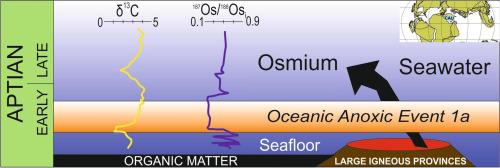Global and Planetary Change ( IF 3.9 ) Pub Date : 2021-09-29 , DOI: 10.1016/j.gloplacha.2021.103652 Rafael Martínez-Rodríguez 1 , David Selby 2, 3 , José M. Castro 1 , Ginés A. de Gea 1 , Luis M. Nieto 1 , Pedro A. Ruiz-Ortiz 1

|
Some of the major Carbon cycle perturbations of the Phanerozoic occurred during the Aptian, in relation to magmatism. The highest temperatures reconstructed for the Cretaceous Period correspond to the Oceanic Anoxic Event of the early Aptian (OAE 1a), an episode of accelerated global change. Here we present a chemostratigraphic study based on osmium isotopes integrated with high-resolution Carbon-Oxygen stable isotope data from the Cau Core (Western Tethys, SE Spain), including a 6.4 Ma record from the early to the late Aptian. This high-resolution study of the continuous and expanded Cau section permits a thorough understanding of the duration of the Aptian events, as well as an evaluation of the mechanisms triggering the abrupt changes of the global carbon and osmium cycles and their interdependence. Here we show that the Large Igneous Province (LIP) Aptian magmatism initiated 550–750 kyr prior to the OAE 1a, and persisted for 1.4 Myr after the event, influencing the composition of seawater for 2.8 Myr. We show a continuous Os isotope record encompassing the OAE 1a and the late Aptian for the first time, and demonstrate that the recovery from the exceptionally unradiogenic composition of seawater Os produced by the dominance of the Ontong Java Plateau volcanism, was slow. Our results demonstrate the different time duration of some events, and the asynchronous relationship between the carbon and osmium cycles
中文翻译:

通过早期阿普蒂安缺氧事件 (OAE 1a) 到阿普蒂安晚期跟踪岩浆活动和海洋变化:来自最西端特提斯群岛(西班牙东南部)Cau 核心的锇同位素的见解
与岩浆作用有关的显生宙的一些主要碳循环扰动发生在阿普蒂安期。为白垩纪重建的最高温度对应于早期阿普蒂安 (OAE 1a) 的海洋缺氧事件,这是全球加速变化的一个事件。在这里,我们提出了一项基于锇同位素的化学地层研究,该研究结合了来自 Cau 核心(西特提斯,西班牙东南部)的高分辨率碳-氧稳定同位素数据,包括从阿普提安早期到晚期的 6.4 Ma 记录。对连续和扩展的 Cau 部分进行的这项高分辨率研究可以彻底了解阿普蒂安事件的持续时间,并评估触发全球碳和锇循环突然变化的机制及其相互依存关系。在这里,我们表明大火成岩省 (LIP) Aptian 岩浆活动在 OAE 1a 之前开始了 550-750 kyr,并在事件发生后持续了 1.4 Myr,影响了 2.8 Myr 的海水成分。我们首次展示了包含 OAE 1a 和晚期 Aptian 的连续 Os 同位素记录,并证明从 Ontong Java 高原火山活动的主导地位产生的海水 Os 的异常非放射性成分中恢复是缓慢的。我们的结果证明了一些事件的不同持续时间,以及碳和锇循环之间的异步关系 我们首次展示了包含 OAE 1a 和晚期 Aptian 的连续 Os 同位素记录,并证明从 Ontong Java 高原火山活动的主导地位产生的海水 Os 的异常非放射性成分中恢复是缓慢的。我们的结果证明了一些事件的不同持续时间,以及碳和锇循环之间的异步关系 我们首次展示了包含 OAE 1a 和晚期 Aptian 的连续 Os 同位素记录,并证明从 Ontong Java 高原火山活动的主导地位产生的海水 Os 的异常非放射性成分中恢复是缓慢的。我们的结果证明了一些事件的不同持续时间,以及碳和锇循环之间的异步关系



























 京公网安备 11010802027423号
京公网安备 11010802027423号